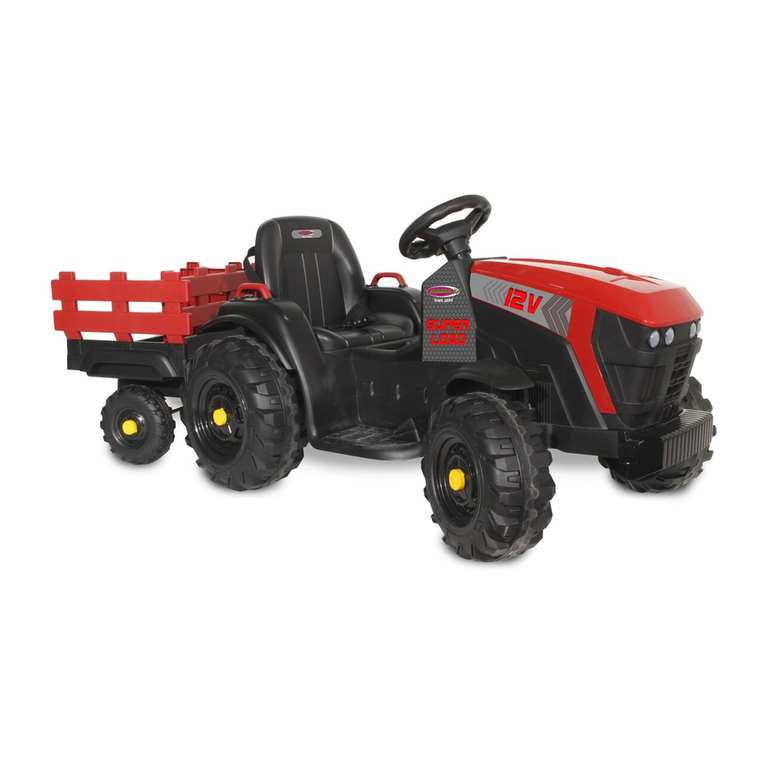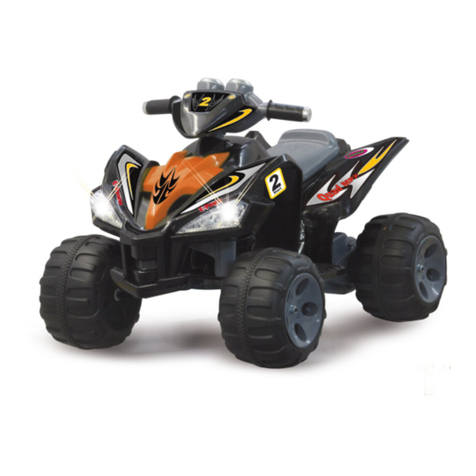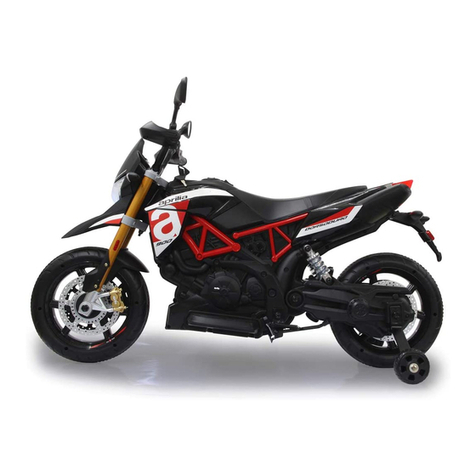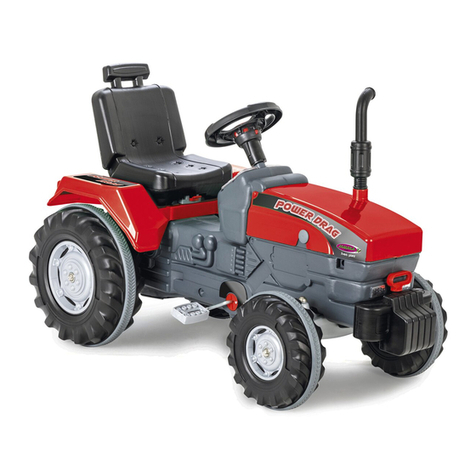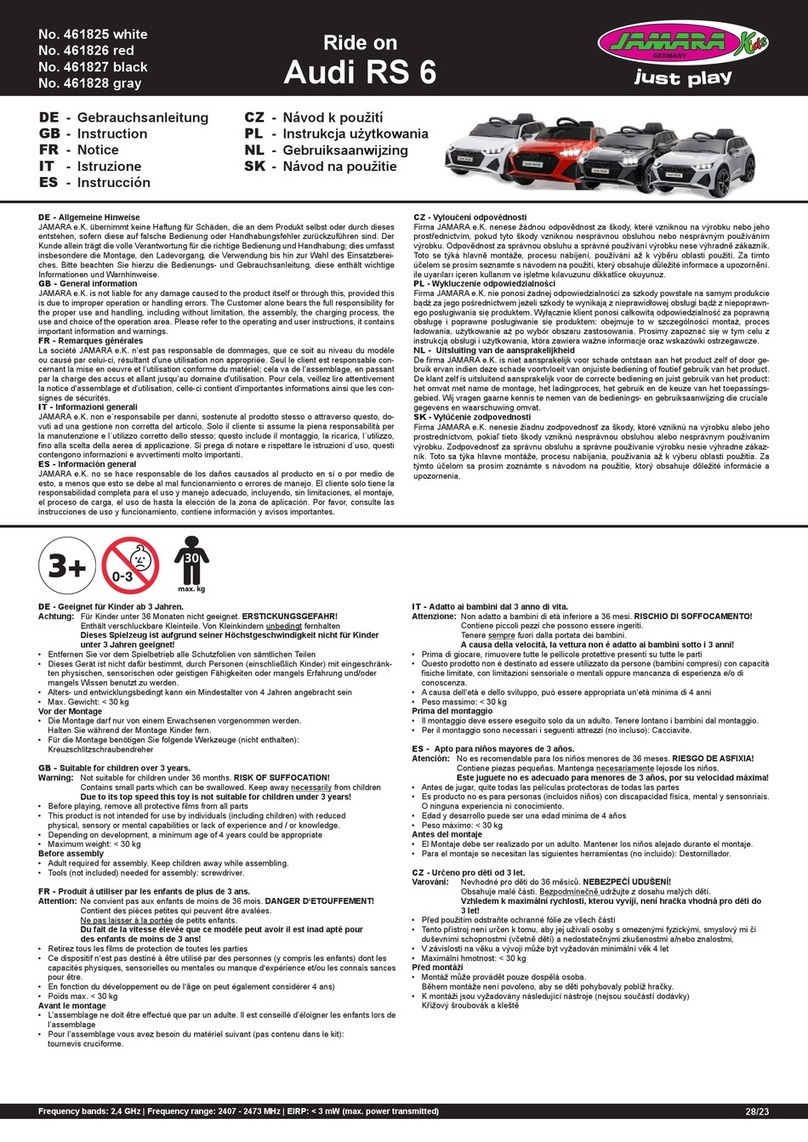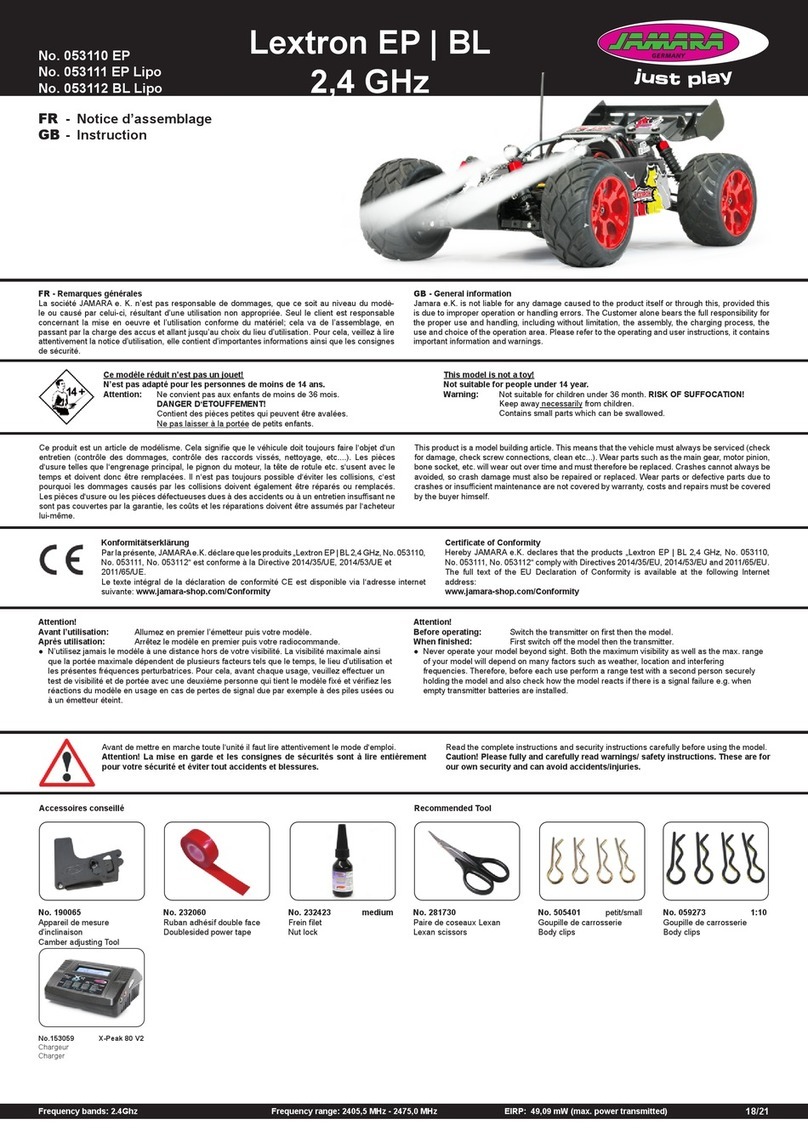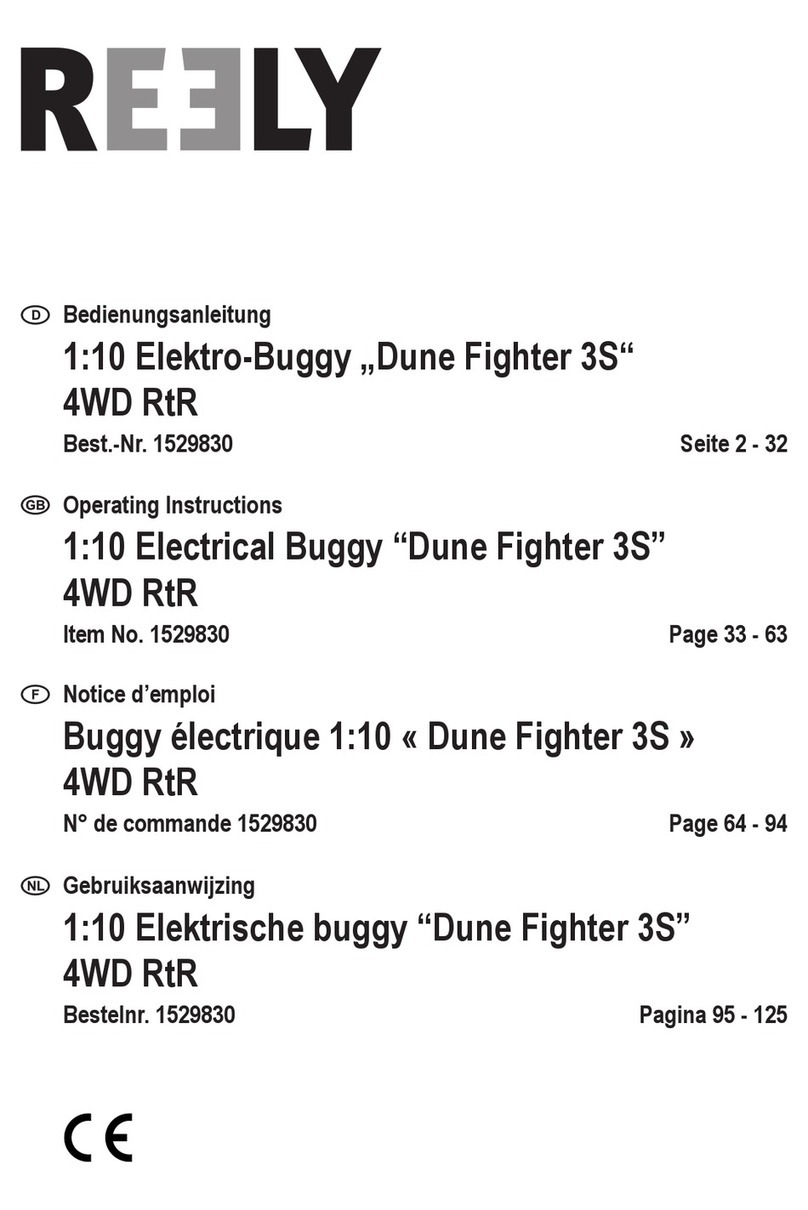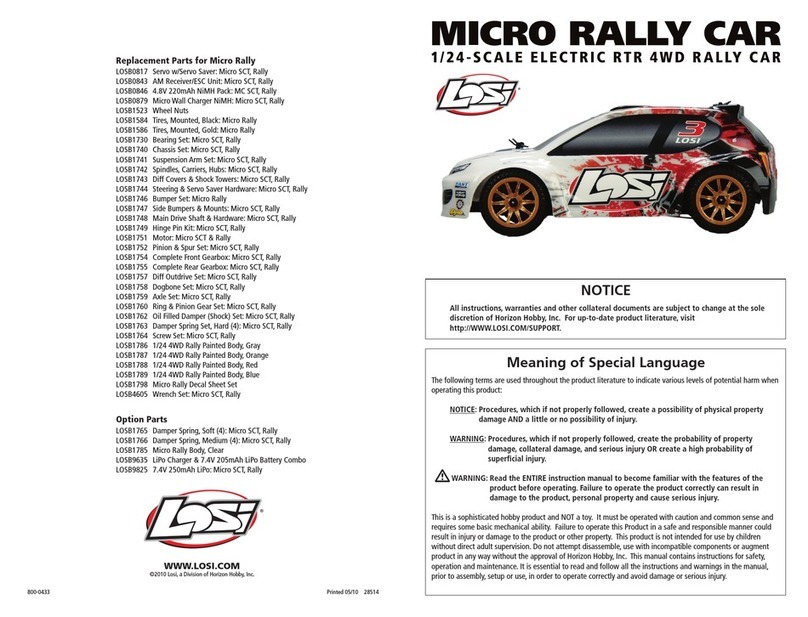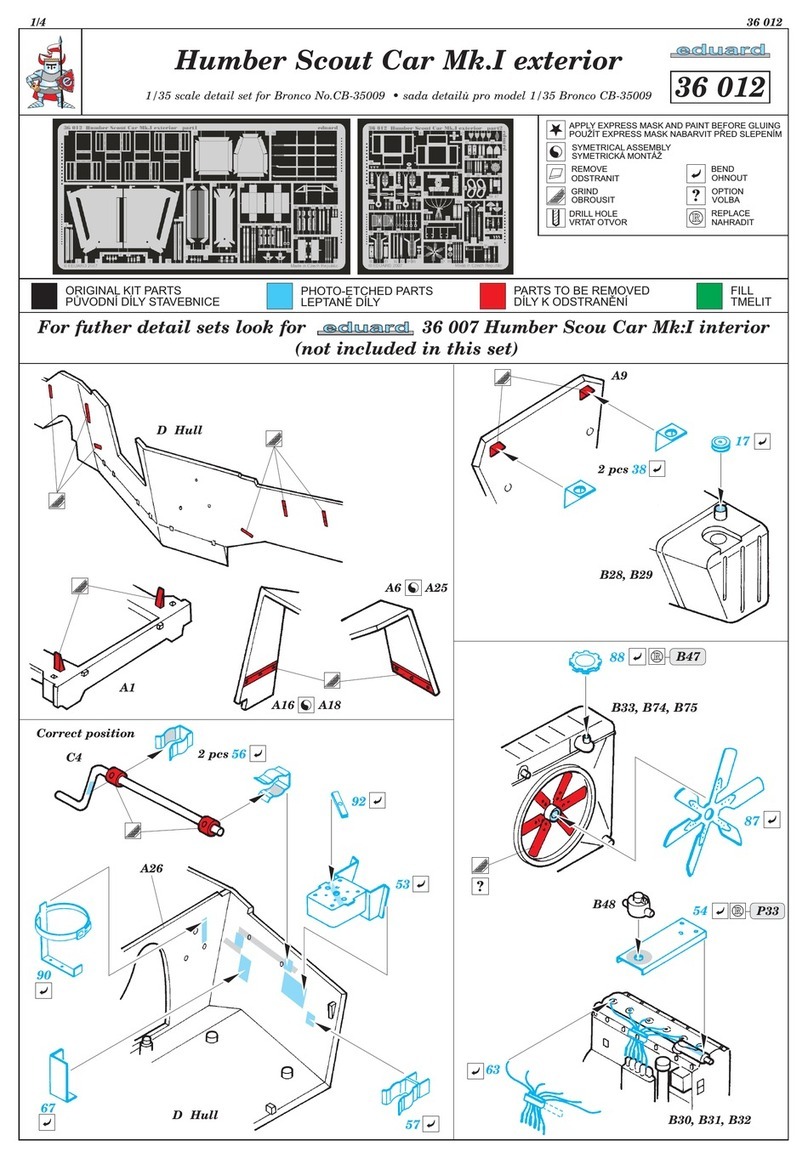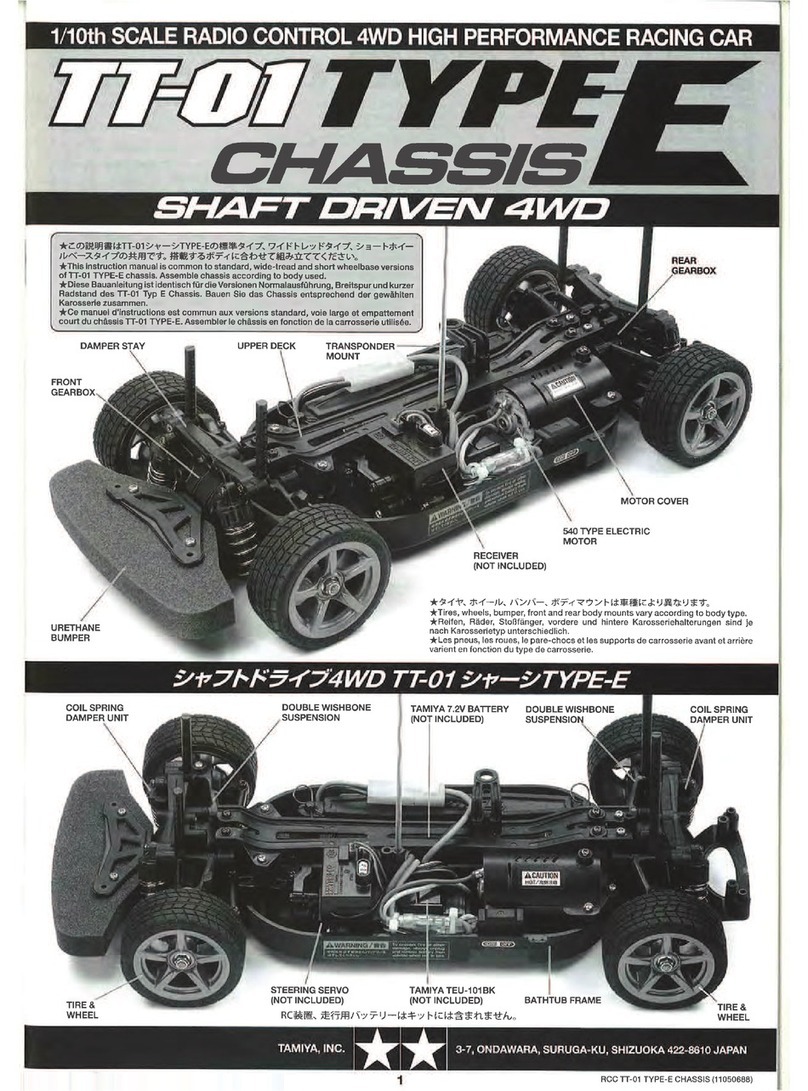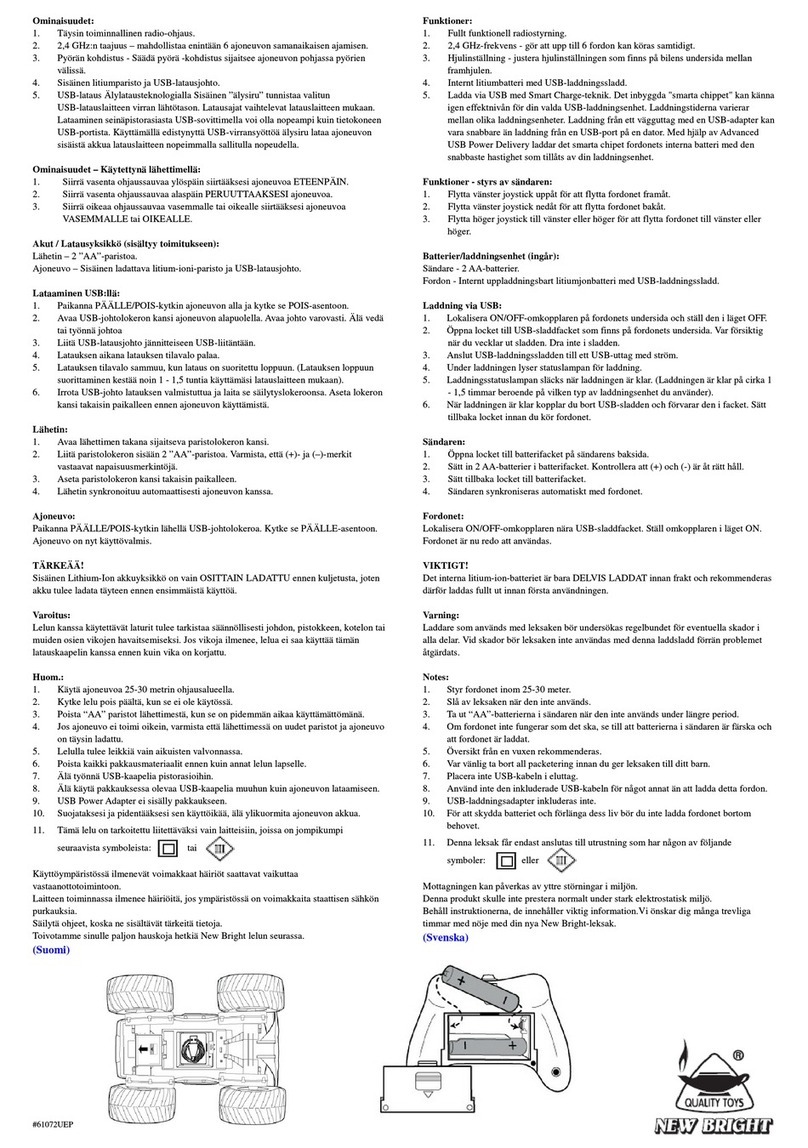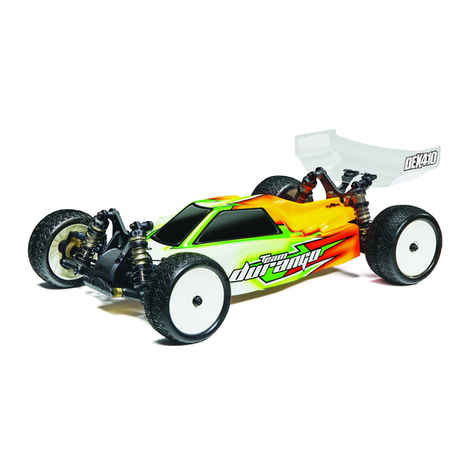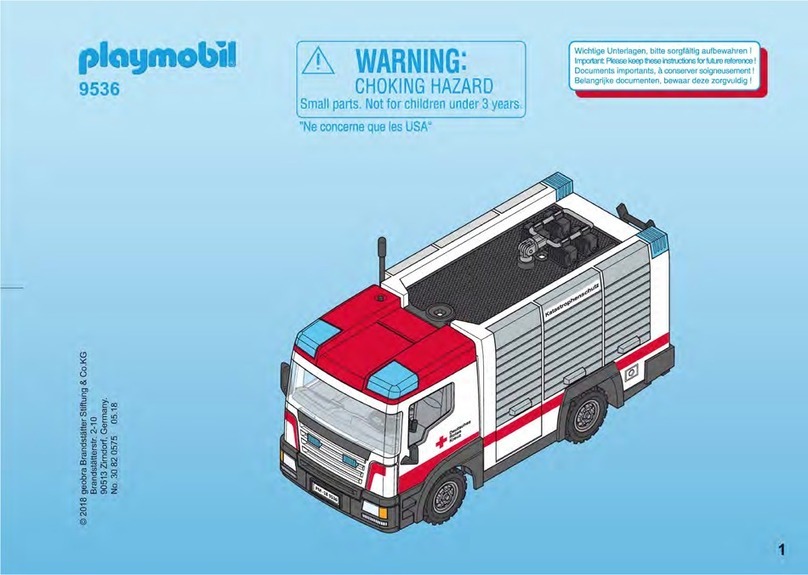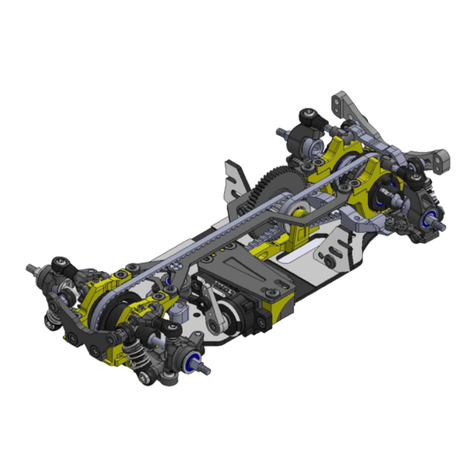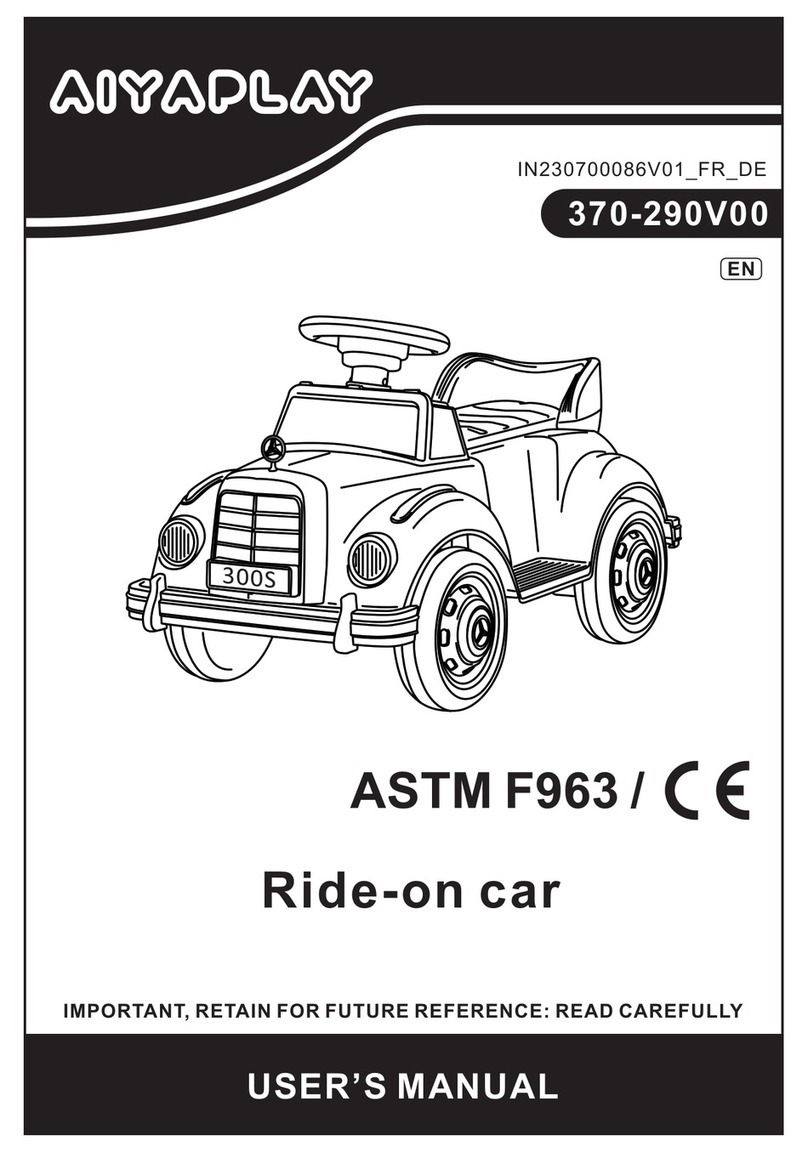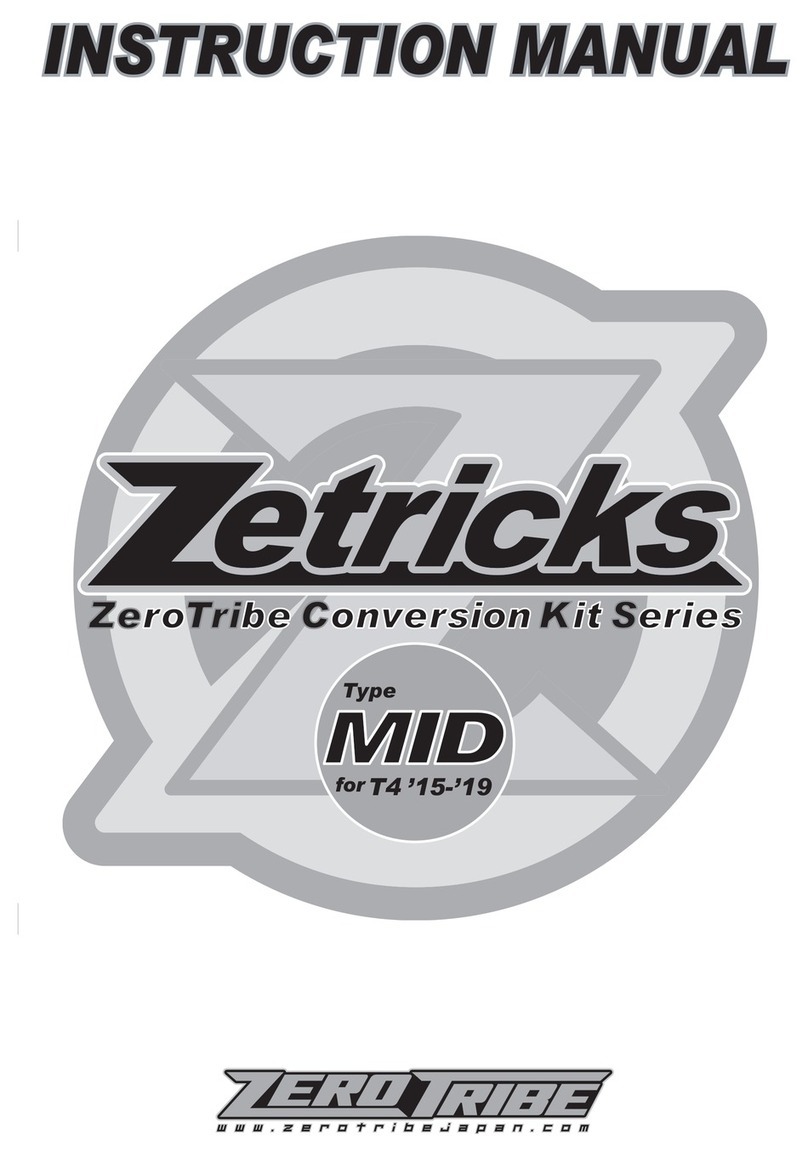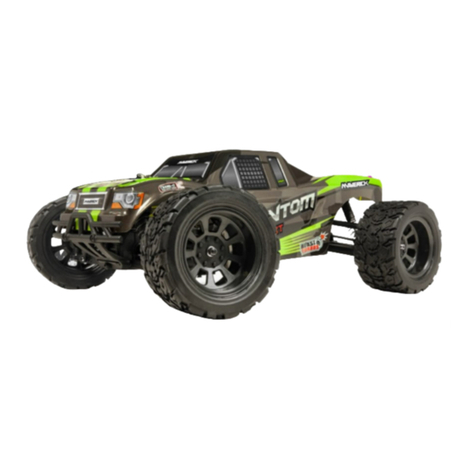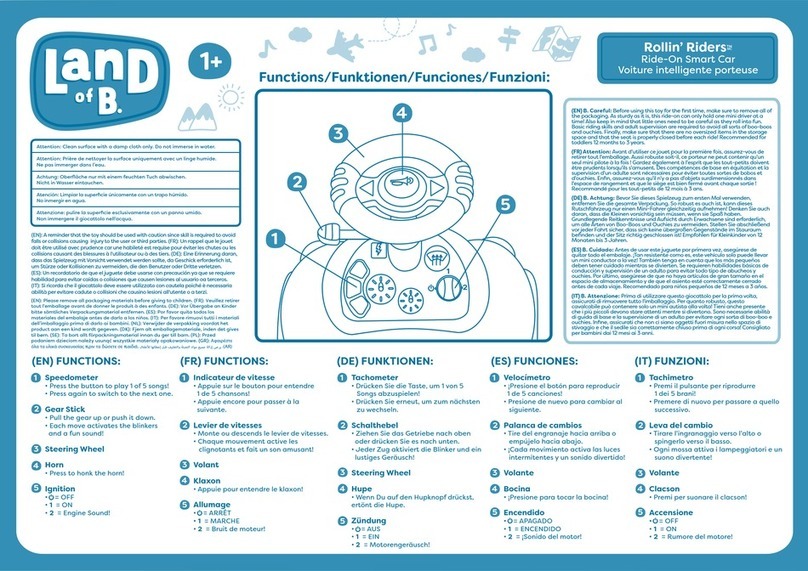
4
Apprendimento della corsa gas / freno
Per prestazioni ottimali, il regolatore deve essere calibrato. In tal modo, le tre
posizioni avanti, indietro e la posizione di folle devono essere specicata. Ci
sono tre ragioni per la necessità di calibrazione:
• Durante il primo avvio
• Effettuando un cambio della trasmittente
• Dopo una riprogrammazione del punto neutro e / o la corsa del servo del
trasmettitore
Durante la regolazione procedere come segue:
1. Accendete il radiocomando, durante che la ricevente è spento.
(Attenzione con sistema di Futaba: In certi casi la funzione del gas è
invertita). La corsa servo deve essere in posizione neutrale. Fare
attenzione che la funziona ABS sia spenta.
2. Poi accendere la ricevente tramite l‘interruttore sul regolatore. Tenendo
premuto il tasto ‚SET‘. Questo vi porterà alla modalità di calibrazione, il
LED inizia a lampeggiare. Appena il LED lampeggia, rilasciare il pulsante.
Se non si rilascia il tasto ‚SET‘ subito dopo il led inizia a lampeggiare e si
entra nella modalità di programmazione. Se non si desidera questo, è
necessario a spegnere nuovamente il regolatore.
3. E´possibile congurare tre parametri:
• Posizione neutra
• Fine corsa marcia avanti
• Fine corsa marcia indietro
In seguito trovate le immagini,dove sono presentati i processi e le
procedure gracamente.
4. Portare la leva del gas in posizione neutrale e premere il tasto ‚SET‘, il
LED verde lampeggia una volta e il motore emette un suono. Portare la
leva del gas in posizione nale per il movimento in avanti e premere il
tasto `SET il LED verde lampeggia due volte e il motore emette due
suoni. Portare la leva del gas in posizione nale per il movimento indietro
e premere il tasto `SET`, il LED verde lampeggia tre volte e il motore
emette tre suoni. Attendere tre secondi, dopodiché è terminato il
processo di calibrazione.
Calibrating the Throttle/Brake
To ensure that your ESC operates correctly it has to be calibrated. During
this process the full throttle, stop and brake positions will be set. There are 3
occasions when the unit must be calibrated.
• Before using the ESC for the rst time
• If you change to a new transmitter
• If the neutral point or servo throw is changed within your transmitter
To calibrate the system, please proceed as follows:
1. Ensure that the receiver is switched OFF and switch ON the transmitter. If
you are using a Futaba transmitter, please ensure that you have reversed
the throttle function. The throw should be set to neutral. If the transmitter
is tted with an ABS function this must be de-activated.
2. Press and hold down the ‘SET‘ button on the ESC and switch the receiver
switch ON. This will switch the ESC into Calibration’ mode and the LED
will begin to blink. If you fail to release the ‘SET’ button as soon as the
LED blinks, the ESC will enter ‘Programming’ mode. If this happens, you
will have to switch the ESC off and start again to enter ‘Calibration’ mode.
3. 3 Parameters can be set here:
• Neutral point
• Full throttle forwards
• Full throttle reverse
The procedure for setting these 3 points is outlined below:
4. Ensure that the throttle control is in the neutral position and press the
‘Set‘ button. The green LED will ash once and the motor will omit a
beep. Move the throttle control to the full throttle (forwards) position and
press the green ‘Set‘ button. The green LED will ash twice and the motor
will omit 2 bleeps. Move the throttle control to the full reverse position and
press the ‘Set‘ button. The green LED will ash 3 times and the motor will
omit 3 bleeps. 3 Seconds after this procedure has been followed, the
motor is ready for use.
Segnali e dispositivi di sicurezza
Durante il normale funzionamento, i segnali LED hanno i seguenti signicati:
a. Quando l‘acceleratore è in posizione neutra, non è accesa né la LED rossa né la LED verde.
b. Il LED rosso si accende quando il veicolo è in movimento in avanti o indietro. Durante la frenata, il LED rosso
lampeggia velocemente.
c. I LED verde si accende quando il generatore di gas e in max. posizione avanti o indietro.
Tramite segnali d’avviso, il regolatore richiama l‘attenzione su determinate condizioni:
1. Durante l´avvio, il processore controlla la tensione d’ingresso, quando è al di fuori dei limiti consentiti, un tono duale
con una pausa di un secondo tra i singoli segnali „bipbip, bip-bip, bip-bip-“ lo segnala.
2. Quando il segnale d’ingresso non è corretto, sarà generato un suono con una pausa di due secondi tra i singoli
segnali „bip-,-bip, bip-“
Questo regolatore è dotato di una serie di dispositivi di sicurezza per un funzionamento sicuro:
1. Spegnimento sottotensione:
Non appena la tensione di una batteria LiPo, per un periodo di 2 secondi, va sotto la soglia impostata, il motore si
spegne. Notate che il motore non può essere riavviato, se la tensione di una cella è inferiore a 3,5 V.
Batterie NiCd o NiMH con una tensione compresa tra 9,0 V e 12,0 V, sono trattate come una batteria LiPo a tre
celle. Le batterie con meno di 9.0 V come un due-celle LiPo-Pack. Se per esempio, una batteria NiMH ha una
tensione di 8,0 V, e la soglia è impostata a 2,6 V per cella LiPo, l‘arresto avviene a 5,2 V (2 x 2,6 V). Cosi anche le
celle di NiCd, sono efcacemente protetti contro una scarica profonda.
2. Spegnimento per sovratemperatura:
Appena la temperatura del regolatore, per una durata di 5 secondi, supera il valore di 95 ° C, il motore si spegne.
Dopo lo spegnimento, è necessario lasciare raffreddare il regolatore, altrimenti il regolatore sarà danneggiato.
Questa funzione non può essere disabilitata!
3. Segnale d´ingresso difettoso
Se il segnale d’ingresso per un periodo di 0,2 sec è rilevato come errato e motore si spegne.
LED’s, errors and protection
In normal use the LED will illuminate as follows:
a. If the throttle control is in the neutral position, neither the red or green LED will illuminate.
b. The red LED will illuminate if the vehicle is driving forwards or in reverse. If the vehicle is braking, the red LED will
ash rapidly.
c. The green LED will illuminate when the vehicle is at full throttle either forwards or in reverse.
In certain circumstances the ESC will omit an acoustic tone to warn you of a problem:
1. On switching on, the ESC will check the battery pack voltage and if it falls outside the correct values it will omit
double signals followed by a 1 second pause: “beep-beep-, beep-beep-, beep-beep-”
2. If the ESC does not receive a signal from the transmitter it will omit single signal followed by a 2 second pause:
“beep-, beep-, beep-”
The ESC has ben equipped with a series of protective circuits to ensure safe operation:
1. Low voltage cut-off:
If the voltage drops below the set value for more than 2 seconds the ESC will switch the motor off. Please note that
the motor cannot be started again if the voltage is below the choosen value per cell.
If a NiCd or NiMH pack with a voltage of between 9 and 12 Volts is connected, the ESC will treat is as if it was a 3 cell
LiPo pack. If the pack voltage is below 9.0 Volts, the ESC will react as if it was a 2 cell LiPo pack. For example, if a
NiMH pack is connected with a nominal voltage of 8 Volts and the cut-off value is set to 2.6 Volts per cell, the ESC
will switch the motor off at 5.2 Volts (2 X 2.6 V). This will protect the NiMH packs from ‘deep discharge’.
2. Temperature cut-off
If the internal temperature of the ESC rises above 95°C for more than 5 seconds the motor will switch off. After the
ESC switches off it has to cool down before operating again. Otherwise the ESC will be damaged. This function
should not be disabled!
3. Signal loss
If the signal is lost for more than 0.2 seconds the ESC will switch the motor off.
SET-Taste beim Einschalten drücken
Press SET button while switching on
IT - Soluzione dei problemi
Anche se questo controller per modelli d´auto e camion è
sottoposto a un controllo di qualità continuo, possano
manifestarsi dei problemi. Nella tabella seguente sono
elencati i possibili problemi e le relative soluzioni.
Dopo l‘accensione il motore non parte e non rilascia
alcun segnale acustico.
1. La batteria o il collegamento alla batteria non sono in
ordine.
- Controllare i cavi, connettori e batteria.
Dopo l‘accensione, il motore non parte ed emette
un segnale di allarme, un doppio segnale acustico
ogni secondo.
1. La tensione d’ingresso non è corretta, è troppo alta o
troppo bassa.
- Controllare la tensione della batteria.
Dopo l‘accensione, il motore non parte ed emette un
segnale di allarme continuo ogni 2 secondi.
1. Il segnale d’ingresso è identicato come errata.
- Controllare il trasmettitore e il ricevitore, e il lo di
collegamento ricevitore del regolatore.
Il motore gira in una direzione errata.
1. I collegamenti del motore in senso inverso.
- Sostituire due cavi di collegamento tra il motore e il
regolatore.
DImprovvisamente il motore non gira più
1. Il segnale d´ingresso non è corretto.
- Controllare trasmettitore, ricevitore e il cavo servo.
2. La batteria ha una tensione troppo bassa.
- Caricare la batteria.
Funzionamento irregolare del motore, balbetta.
1. Vi è una connessione allentata.
- Controllare tutti i collegamenti in grande dettaglio.
2. La trasmissione radio subisce forti interferenze
intermittenti.
- Ruotare il controllo spento e riacceso. Se ancora
non si ottiene un corretto funzionamento, utilizzare
il vostro veicolo in qualsiasi altro luogo.
GB - Troubleshooting
Although this ESC has been subjected to the most strin-
gent quality control it is possible that you may experience
a problem during operation. In this case please use the
table below to assist in fault nding.
The motor will not rotate after switching on.
No signal is present.
1. The battery pack or battery pack connectors are
faulty.
- Check all of the connectors and the battery pack.
The motor will not turn after switching on. The ESC
omits double signals with a 1 second interval.
1. The input voltage is too high or too low.
- Check the battery pack voltage.
The motor will not turn after switching on. The ESC
omits single signals with a 2 second interval.
1. No or a poor receiver signal.
- Check both the transmitter and receiver as well as
the ESC connecting cable.
The motor turns in the wrong direction.
1. The motor connecting cables are swapped
- Swap 2 of the ESC/motor connecting cables
The motor suddenly stops turning.
1. The battery voltage is too low.
- Charge the battery pack.
2. No signal.
- Check the transmitter, receiver and all of the cables
Only steering response
The motor stutters or runs irregularly.
1. One of the connectors is loose.
- Carefully check all of the connectors.
2. The receiver has intermediate interference.
- Switch the system off and then on. If the interfe-
rence persists, operate the model in another
location.


